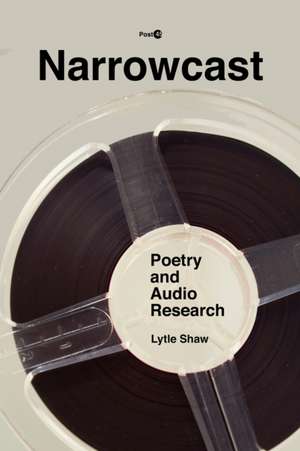Narrowcast – Poetry and Audio Research: Post*45
Autor Lytle Shawen Limba Engleză Paperback – 11 iun 2018
| Toate formatele și edițiile | Preț | Express |
|---|---|---|
| Paperback (1) | 263.63 lei 6-8 săpt. | |
| MK – Stanford University Press – 11 iun 2018 | 263.63 lei 6-8 săpt. | |
| Hardback (1) | 777.47 lei 6-8 săpt. | |
| MK – Stanford University Press – 11 iun 2018 | 777.47 lei 6-8 săpt. |
Din seria Post*45
-
 Preț: 177.64 lei
Preț: 177.64 lei -
 Preț: 279.88 lei
Preț: 279.88 lei -
 Preț: 228.82 lei
Preț: 228.82 lei -
 Preț: 201.29 lei
Preț: 201.29 lei -
 Preț: 223.09 lei
Preț: 223.09 lei -
 Preț: 199.72 lei
Preț: 199.72 lei -
 Preț: 231.50 lei
Preț: 231.50 lei -
 Preț: 199.72 lei
Preț: 199.72 lei -
 Preț: 131.11 lei
Preț: 131.11 lei -
 Preț: 230.13 lei
Preț: 230.13 lei -
 Preț: 200.98 lei
Preț: 200.98 lei -
 Preț: 159.22 lei
Preț: 159.22 lei -
 Preț: 216.26 lei
Preț: 216.26 lei -
 Preț: 217.79 lei
Preț: 217.79 lei -
 Preț: 460.47 lei
Preț: 460.47 lei - 19%
 Preț: 645.19 lei
Preț: 645.19 lei -
 Preț: 479.18 lei
Preț: 479.18 lei - 19%
 Preț: 448.67 lei
Preț: 448.67 lei - 23%
 Preț: 776.00 lei
Preț: 776.00 lei -
 Preț: 260.76 lei
Preț: 260.76 lei -
 Preț: 212.07 lei
Preț: 212.07 lei -
 Preț: 266.52 lei
Preț: 266.52 lei -
 Preț: 261.72 lei
Preț: 261.72 lei -
 Preț: 261.72 lei
Preț: 261.72 lei -
 Preț: 266.52 lei
Preț: 266.52 lei - 19%
 Preț: 705.10 lei
Preț: 705.10 lei -
 Preț: 155.89 lei
Preț: 155.89 lei
Preț: 263.63 lei
Nou
50.45€ • 52.48$ • 41.65£
Carte tipărită la comandă
Livrare economică 12-26 aprilie
Specificații
ISBN-10: 1503606562
Pagini: 272
Dimensiuni: 154 x 228 x 20 mm
Greutate: 0.43 kg
Editura: MK – Stanford University Press
Seria Post*45
Cuprins
This chapter uses the reel-to-reel recordings Allen Ginsberg made on a cross-country trip in 1966 to focalize the contested status of audio research as it was then fought over by the New Left and the U.S. state. Reframing Frank O'Hara's suggestion in "Personism" that greater immediacy with his friends "Allen" (Ginsberg) and "Roi" (LeRoi Jones) might be achieved by calling them, the chapter considers what it means for postwar poetics that such New Left poets were often under state audio surveillance. Bringing poets, literary critics and the state into unexpected proximity, the chapter offers an account of the guiding assumptions and pitfalls associated with the CIA and FBI's often Yale-trained literary critics, demonstrating how all three confront the overwhelming of voice by its noisy sonic environment and how the state's theory of totality might be compared to that of famous literary theorists like Fredric Jameson.
Chapter two explores Larry Eigner's development of a counter-temporality in relation to his dominant reception, the domestic mediascape he daily negotiated, the surrounding cold war defense infrastructure, and the Luce media empire's regulation of Americans' experience of time. Presenting Eigner's reflexive daily neighborhood sound and sight monitoring as a counterpoint to the Cold War surveillance jets that performed the same function over his neighborhood, the chapter shows how the urgent events that course through Eigner's airspace get recast by the poet's horizontal model of time. Eigner's role as an alternate broadcasting system then gets drawn out through an analysis of the ways that the Luce media (referenced by Eigner) took on the roll of organizing national time at the level of the week, month, year and even century.
Chapter three positions Charles Olson's education in American studies at Harvard and his work for the OWI in relation to postwar area studies and models of evidence, research and network building demonstrated on his recordings, whose confrontational dynamics and insistence on the real time of research are related to postwar sound and performance art. The chapter then uses Henry Kissinger's Harvard education, including Paul de Man's French tutoring, as a way to study the infrastructure of postwar area studies that underlay Kissinger's later audio surveillance, including his taping of Allen Ginsberg. Comparing Kissinger's understanding of tape to Olson's, the chapter draws out the "avant-garde" nature of Kissinger's audio research in which documentation transcends a hypothesis, a claim that gets tested by considering a 1975 court case in which Hayden White brought suit against the LAPD for planting officer pretending to be students in his class at UCLA.
Considering the sound documentaries of R. Murray Schafer and Glenn Gould, this chapter first places the origins of sound studies within nationalist Canadian conceptions of geography and culture before then outlining the American Cold War technological infrastructure that preceded these musicians' movements into Canadian space, especially the three lines of radar stations erected to monitor Soviet incursions into the North American continent. The chapter then considers the mechanics of this system via a case study of one of its functionaries, sergeant LeRoi Jones, whose practice missions of atomic reprisal aboard a B36 peacemaker were signaled by a hellish siren particularly noted by the sergeant. The chapter concludes by following this siren-sound into the poet and music critic's later work, as Amiri Baraka, fashioning exemplary sounds of Black Nationalism.
